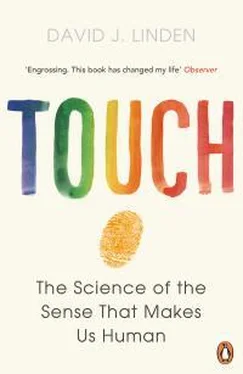
Francis McGlone, a well-known researcher on tactile perception, is fond of asking, “Why is it that there is chronic pain but no chronic pleasure?” It’s a good question. We’ve seen how pain is essential for inciting behaviors that will minimize tissue damage, and how those who lack pain perception rarely survive past childhood. Yet pain can also outlast its usefulness, tormenting people long after tissue damage has healed, sometimes for a lifetime.
Persistent pain is produced not only by changes to the endings of pain-sensing fibers. There are also alterations at the synapses in the spinal cord, where these fibers contact the neurons of the spinal dorsal horn. When electrical spikes are conveyed to the central terminal of pain-sensing C-fibers, they cause release of the excitatory neurotransmitter glutamate. Glutamate diffuses across the tiny synaptic cleft separating the two neurons and binds to glutamate receptors on the dorsal horn neuron, resulting in the propagation of pain signals through the spinal cord and on to the brain. When this synapse is repeatedly stimulated, as in the case of persistent pain, it becomes stronger and more efficient. This results from a number of factors, including increased glutamate release, more glutamate receptors on the dorsal horn neuron, as well as changes to the voltage-gated ion channels in the dorsal horn neuron that promote repeated spike generation. 16These changes can be very long lasting, like memories. (Indeed, it is thought that some of the molecular and cellular changes that encode memories in the brain are similar to those that underlie this form of chronic pain originating in the spinal cord.) Even when the inflammatory response in the skin (or other tissue) has completely faded and the pain-sensing capacities of the nerve endings have returned to normal, changes in the spinal cord can endure for months or years. In some cases, chronic pain originating in the spinal cord can last a lifetime. It would be enormously beneficial to find a way to selectively weaken these pain-transmitting synapses in the spinal dorsal horn, and, not surprisingly, it is an active area of research.
One type of persistent pain that is particularly resistant to treatment is phantom limb pain. Following amputation, about 60 percent of patients experience a feeling of chronic pain in the limb that was removed. Sometimes it’s an aching; at other times it’s experienced as burning. The phenomenon is more likely to occur when amputation occurs in adulthood, and is equally likely to result from a surgical amputation as it is from a traumatic loss of limb. Originally it was thought that phantom limb pain resulted from damaged nerve endings in the stump, but neither repeated surgery on the stump nor local anesthetics delivered to the area have been shown to relieve it.
It is likely that at least a portion of phantom limb pain is a function of persistent strengthening of pain fiber-dorsal horn neuron excitatory synapses. For years amputation surgery was performed solely under general anesthesia. In this scenario, the pain signals from the procedure travel from the periphery to the spinal dorsal horn but are blocked at later stages from reaching the brain. The incidence of phantom limb pain appears to be somewhat reduced when, in addition to a general anesthetic, local anesthetics are given to numb the amputated region prior to and during the amputation surgery, preventing the pain signals from reaching the spinal dorsal horn at all. Drugs that inhibit the persistent strengthening of the synapses received by the dorsal horn neurons have also shown some limited promise for reducing the incidence of phantom limb pain when used in this fashion. 17
When the synapses that convey pain information in the spinal cord are persistently strengthened, the signals that spinal cord neurons send to the brain will be altered as well, as, in turn, will the brain itself. In one sense the situation is much like that we discussed in chapter 2, where the representation in the body map of the fingering hand of experienced string players was expanded following years of practice. Patients with amputations who experience phantom limb pain sometimes show enlarged representation of both the affected limb area and other regions in the body map of the primary somatosensory cortex. Amputees who do not suffer from chronic pain, however, do not show these enlargements. 18

On April 13, 2003, Private Dwayne Turner, a U.S. Army combat medic, was with a small unit that came under attack as they were unloading supplies in a makeshift operations center about thirty miles south of Baghdad. Recounting that day in an interview many months later, Turner recalled:
… a[n enemy] guy lugged a grenade over one of the walls, and me and some other guys were right in the middle of the blast. I ran to the front of the vehicle and I saw some of the wounded, and I kind of sat back and assessed the situation because there were still rounds going around. I was like, well, there’s guys going down and, you know, I’m not just going to leave them there. I got to doing my thing, so I started going to work … I know these guys. I know them, know them back home, we eat with these guys, we sleep with these guys, and you know, you just don’t want nobody to die on your watch. They’re pretty much your brothers. You’re going to war with your family. I know that if my real life brother was out there, I’d go and save him.
Turner had taken shrapnel from the grenade blast in his right leg, thigh, and abdomen, but it didn’t slow him down very much. He dashed out from cover repeatedly to retrieve his fallen comrades and pull them to safety, and in the course of doing so was shot twice, one bullet hitting his left leg and another breaking a bone in his right arm. He barely noticed that he’d been shot.
I saw bullets going around and I thought actually that the bullets were hitting the ground and they were, you know, dust or rocks were popping up and hitting me, because I felt like little nicks in certain places. But other than that, I really didn’t know until somebody told me, he was like, “Doc, Doc, you’re bleeding.” I was like, no, that’s not me, that’s somebody else. Trying to pass the buck, but I guess it was [me]. 19
Private Turner eventually collapsed from blood loss, but a few minutes later he had to be restrained from returning to help his fellow soldiers. He and the other wounded soldiers were later evacuated by helicopter. The army, in awarding Dwayne Turner the Silver Star for valor, estimated that at least twelve soldiers would have died without his actions.
While it is remarkable that in the heat of combat Private Turner was able to ignore the pain from his shrapnel wounds and did not even realize he’d been shot, it does not diminish his heroism at all to note that ignoring severe pain in the heat of battle is not unusual. Lieutenant Colonel Henry Beecher compiled statistics on pain in the wounded soldiers he treated during the Allied invasions of Italy and France in World War II. He wrote that about 75 percent of badly wounded men reported such little pain that they refused pain-relief medication when offered it on the field of battle. Yet a few days later, when recovering in a hospital, these same patients protested vigorously at the minor pain of an inept blood draw, just like anyone else would. 20Soldiers are not superhumans with absurdly high pain tolerances. Rather, they are ordinary people who are thrust into extraordinary situations in which the cognitive and emotional stressors of combat serve to blunt pain.
When I was five years old, going to the pediatrician to get a routine immunization seemed like a kind of death sentence. Like Pavlov’s dog’s, my heart would speed up as soon as my mother’s car neared the doctor’s office. The blond wood paneling of the hallways in the medical building, the tap of my mother’s heels on the tile floor, and the smell of alcohol pads all reminded me of the last horrible injection. When the time for the procedure arrived, I was so laser-focused on that one patch of skin on my left arm that my eyes bugged out. The tiny prick of the needle felt as if a steak knife had been thrust deep into my muscle and twisted. As I howled in pain, the doctor observed drily, “What a dramatic kid—a real Sarah Bernhardt.”
Читать дальше













